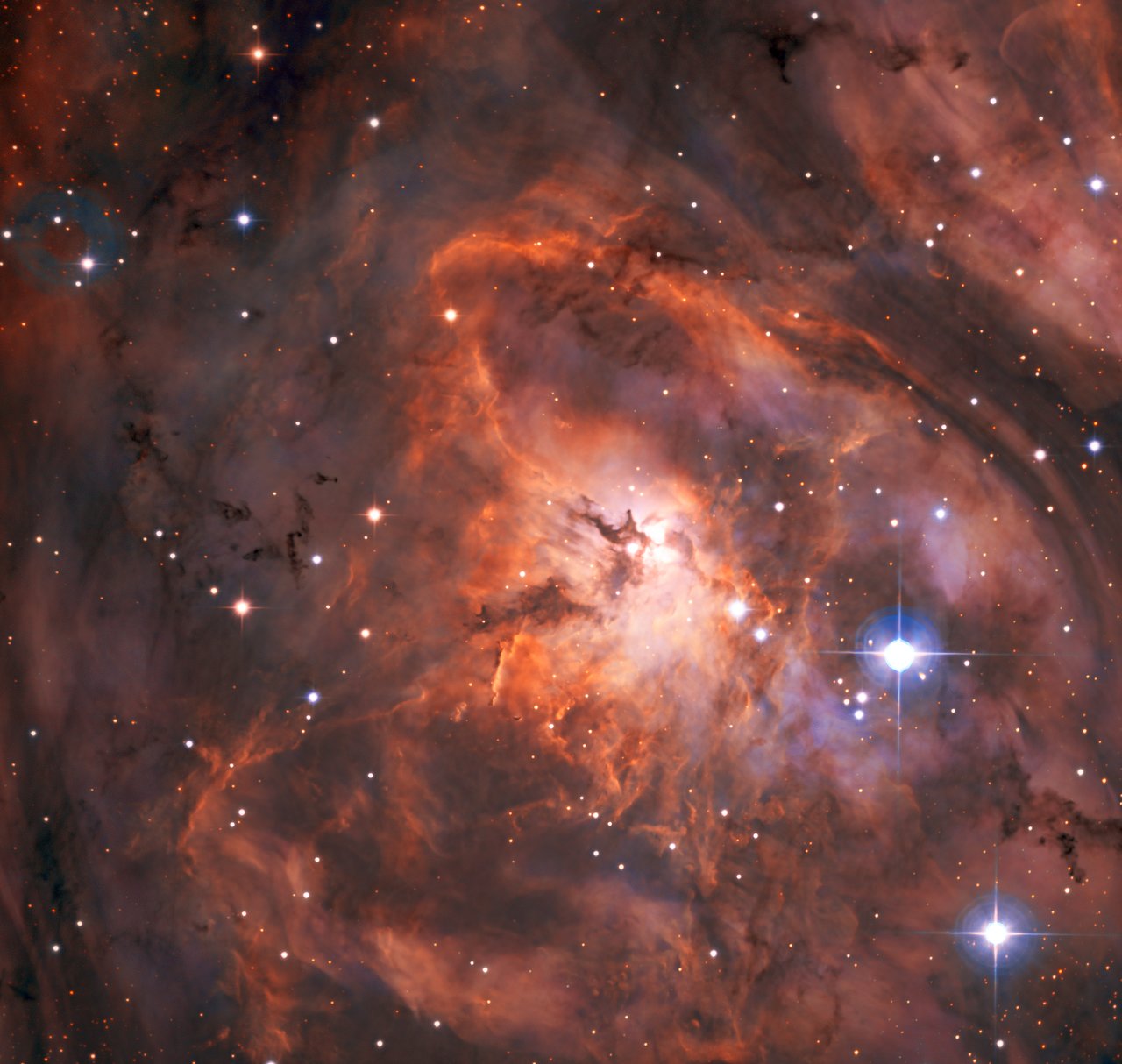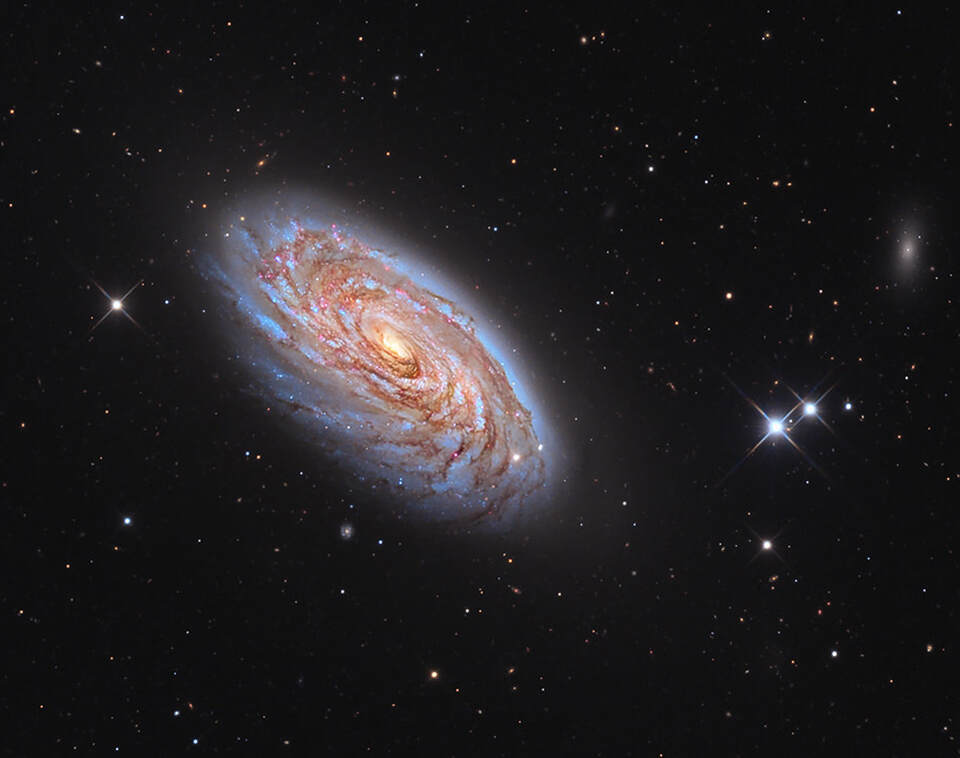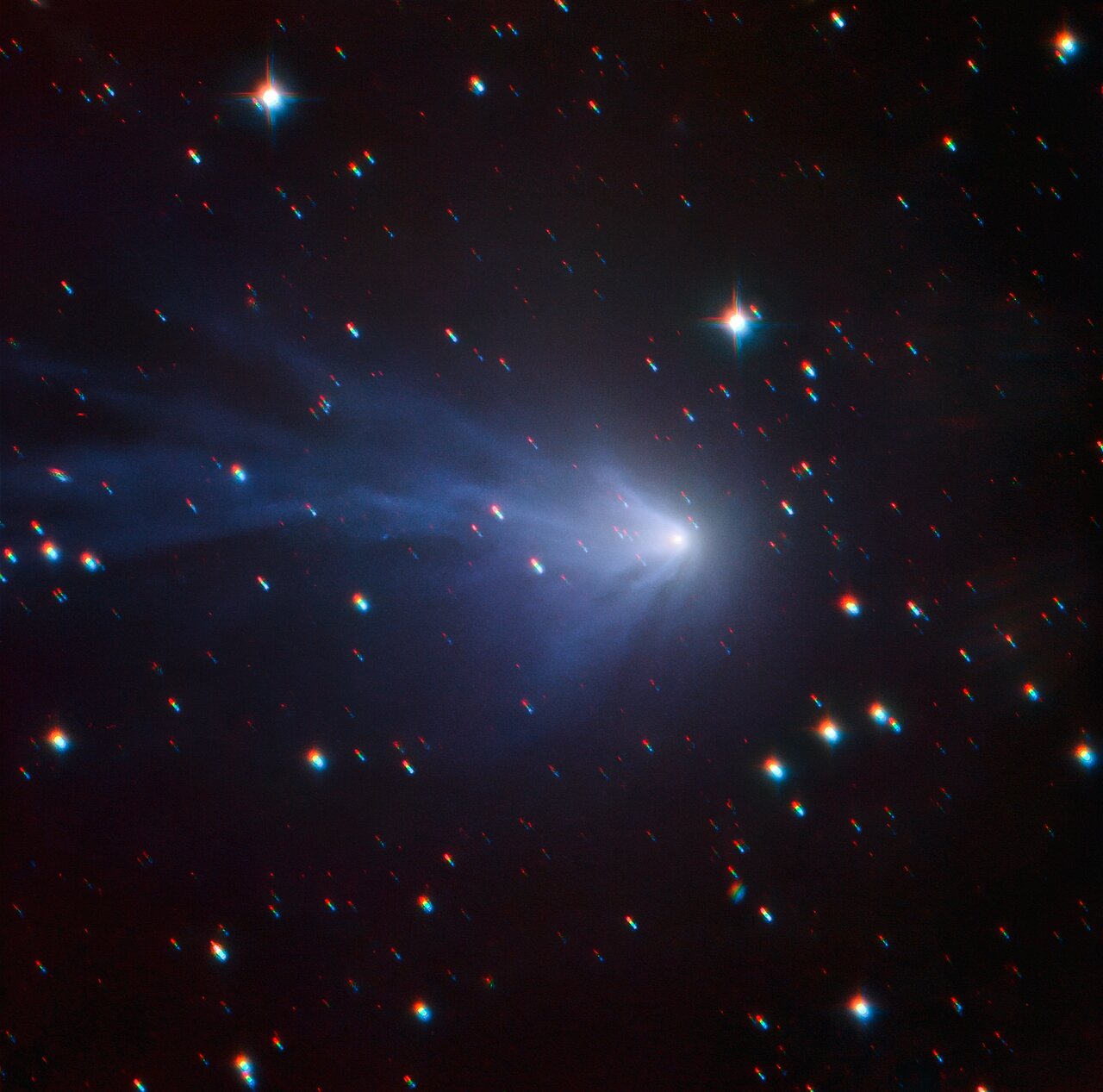Blog
If you had a brand new state-of-the-art telescope facility, what would you look at first? Researchers at the SPECULOOS Southern Observatory — which comprises four small telescopes, each with a 1-metre primary mirror — chose to view the Lagoon Nebula. This magnificent picture is the result, and is one of the SPECULOOS’ first ever observations. The nebula is a cloud of dust and gas in our galaxy where new stars are being born, and is found roughly 5000 light-years from us. This striking image is made even more impressive by the fact that the SPECULOOS isn’t actually designed to study nebulae. The name says it all — SPECULOOS, the Search for habitable Planets EClipsing ULtra-cOOl Stars. In other words, the primary mission of this telescope facility is to find Earth-like planets orbiting faint nearby stars. The candidates it discovers will be passed over to larger telescopes, such as ESO’s forthcoming Extremely Large Telescope (ELT), to be studied in more detail. SPECULOOS is located at ESO’s Paranal Observatory in the Atacama Desert of Chile, taking full advantage of the location’s dark skies, ideal atmospheric conditions, and the support systems ESO has there, from telescope infrastructure to staff accommodation. It will have a partner, the SPECULOOS Northern Observatory, in the Canary Islands, which will hunt for planets in the northern skies not visible from Chile. Together they promise to vastly expand our knowledge of the exoplanets in our neighbourhood.

Leslie Johnson (June 20, 1933 – August 22, 2018), better known as Lazy Lester, was an American blues musician who sang and played the harmonica and guitar. His career spanned the 1950s to 2018.
Best known for regional hits recorded with Ernie Young’s Nashville-based Excello Records, Lester also contributed to songs recorded by other Excello artists, including Slim Harpo, Lightnin’ Slim, and Katie Webster. Cover versions of his songs have been recorded by (among others) the Kinks, the Flamin’ Groovies, Freddy Fender, Dwight Yoakam, Dave Edmunds, Raful Neal, Anson Funderburgh, and the Fabulous Thunderbirds. In the comeback stage of his career (since the late 1980s) he recorded new albums backed by Mike Buck, Sue Foley, Gene Taylor, Kenny Neal, Lucky Peterson, and Jimmie Vaughan.
Lester started playing the guitar around age 11 and began performing in his teens around Baton Rouge with Raful Neal, later co-founding the Rhythm Rockers. In the mid-1950s, Lester was on the margins of the Louisiana blues scene. According to Rolling Stone (February 23, 2006), Buddy Guy, before moving to Chicago, had played in Louisiana with some of the old masters: Lightnin’ Hopkins, Lazy Lester, Slim Harpo. When Guy left for Chicago, in 1957, Lester replaced him, on guitar, in a local band – even though Lester, at that time, did not own such an instrument.
more...Eric Allan Dolphy Jr. (June 20, 1928 – June 29, 1964) was an American jazz alto saxophonist, bass clarinetist and flautist. On a few occasions, he also played the clarinet and piccolo. Dolphy was one of several multi-instrumentalists to gain prominence in the same era. His use of the bass clarinet helped to establish the instrument within jazz. Dolphy extended the vocabulary and boundaries of the alto saxophone, and was among the earliest significant jazz flute soloists.
His improvisational style was characterized by the use of wide intervals, in addition to employing an array of extended techniques to emulate the sounds of human voices and animals. He used melodic lines that were “angular, zigzagging from interval to interval, taking hairpin turns at unexpected junctures, making dramatic leaps from the lower to the upper register.” Although Dolphy’s work is sometimes classified as free jazz, his compositions and solos were often rooted in conventional (if highly abstracted) tonal bebop harmony. On June 29, Dolphy died after falling into a diabetic coma. While certain details of his death are still disputed, it is largely accepted that he fell into a coma caused by undiagnosed diabetes.
more...
Chester Burton “Chet” Atkins (June 20, 1924 – June 30, 2001), known as “Mr. Guitar” and “The Country Gentleman“, was an American musician, occasional vocalist, songwriter, and record producer who, along with Owen Bradley and Bob Ferguson, helped create the Nashville sound, the country music style which expanded its appeal to adult pop music fans. He was primarily known as a guitarist. He also played the mandolin, fiddle, banjo, and ukulele.
Atkins’s signature picking style was inspired by Merle Travis. Other major guitar influences were Django Reinhardt, George Barnes, Les Paul, and, later, Jerry Reed. His distinctive picking style and musicianship brought him admirers inside and outside the country scene, both in the United States and abroad. Atkins spent most of his career at RCA Victor and produced records for the Browns, Hank Snow, Porter Wagoner, Norma Jean, Dolly Parton, Dottie West, Perry Como, Floyd Cramer, Elvis Presley, the Everly Brothers, Eddy Arnold, Don Gibson, Jim Reeves, Jerry Reed, Skeeter Davis, Waylon Jennings, Roger Whittaker, and many others.
Rolling Stone credited Atkins with inventing the “popwise ‘Nashville sound’ that rescued country music from a commercial slump,” and ranked him number 21 on their list of “The 100 Greatest Guitarists of All Time”. Among many other honors, Atkins received 14 Grammy Awards and the Grammy Lifetime Achievement Award. He also received nine Country Music Association awards for Instrumentalist of the Year. He was inducted into the Rock & Roll Hall of Fame, the Country Music Hall of Fame and Museum, and the Musicians Hall of Fame and Museum. George Harrison was also inspired by Chet Atkins; early Beatles songs such as “All My Loving” show the influence.
more...Messier 88 (also known as M88 or NGC 4501) is a spiral galaxy about 50 to 60 million light-years away from Earth in the constellation Coma Berenices. It was discovered by Charles Messier in 1781.
M88 is one of the fifteen Messier objects that belong to the nearby Virgo Cluster of galaxies. It is galaxy number 1401 in the Virgo Cluster Catalogue (VCC) of 2096 galaxies that are candidate members of the cluster. M88 appears to be on or ending a highly elliptical orbit, currently on an approximate or direct course toward the cluster center, which is occupied by the giant elliptical galaxy M87. It is currently 0.3 to 0.48 million parsecs from the center and will come closest to the core in about 200 to 300 million years. Its motion through the intergalactic medium of its cluster is creating, as expected, ram pressure that is stripping away the outer region of neutral hydrogen. To date, this has been detected along the western, leading edge of the galaxy.

Willis Robert “Billy” Drummond Jr. (born June 19, 1959) is an American jazz drummer. Billy Drummond was born in Newport News, Virginia, where he grew up listening to the extensive jazz record collection of his father, an amateur drummer and jazz enthusiast. He started playing the drums at four and was performing locally in his own band by the age of eight, and playing music with other kids in the neighborhood, including childhood friends, Roy Wooten, Reggie Wooten and Victor Wooten, who lived a few doors away and through whom he met Consuela Lee Moorehead, composer, arranger, music theory professor, and the founder of the Springtree/Snow Hill Institute for the Performing Arts. He attended Shenandoah College and Conservatory of Music on a Classical Percussion scholarship and, upon leaving school, became a member of a local Top 40 band called The Squares with bass phenom Oteil Burbridge.
In 1986, encouraged by Al Foster, who had invited him to sit in at the Village Vanguard and advised him to take the next step, he moved to New York and almost immediately joined the band, Out of the Blue, with whom he recorded their last album, Spiral Staircase (Blue Note Records). A year later, he joined the Horace Silver sextet, touring extensively with him before becoming a member of Sonny Rollins‘s band, with whom he toured for three years. During this period he also formed long-term musical associations with Joe Henderson, Bobby Hutcherson, Buster Williams, James Moody, JJ Johnson, Andrew Hill, and others.
https://www.youtube.com/watch?v=DDEAVoAqeT8
more...Ernest Ranglin OD (born 19 June 1932) is a Jamaican guitarist and composer who established his career while working as a session guitarist and music director for various Jamaican record labels including Studio One and Island Records. Ranglin played guitar on many early ska recordings and helped create the rhythmic guitar style that defined the form. Ranglin has worked with Theophilus Beckford, Jimmy Cliff, Monty Alexander, Prince Buster, the Skatalites, Bob Marley and the Eric Deans Orchestra. He is noted for a chordal and rhythmic approach that blends jazz, mento and reggaewith percussive guitar solos incorporating rhythm ‘n’ blues and jazz inflections.
Ernest Ranglin was born in Manchester, Jamaica. His family moved to Kingston, where he attended the Providence Primary School, Kingston Senior School and Bodin College. Ranglin’s introduction to music was through two uncles who both played guitar. Initially a self-taught guitarist; he received some tutoring on how to sight-read from a violin player named Tommy Tomlins. At the age of 15, Ranglin joined the Val Bennett Orchestra, which was followed by a period of employment with the Eric Deans Orchestra. While performing locally with these orchestras Ranglin was introduced to the jazz pianist Monty Alexander, which led to a lifelong friendship as well as numerous musical collaborations.
more...Albert King (1912–1981), known as Bertie King, was a Jamaican jazz and mento musician. He played the clarinet and the saxophone. King was born in Panama, and raised in Kingston, where he attended Alpha Boys School.
During the 1930s he led his own band, Bertie King and his Rhythm Aces, described at the time as “Jamaica’s Foremost Dance Orchestra”. In 1936 he left for England, sailing on the same ship as his friend Jiver Hutchinson. In London he joined Ken Snakehips Johnson‘s West Indian Dance Band, and later played with Leslie Hutchinson’s band. He also worked with visiting American musicians including Benny Carter, George Shearing and Coleman Hawkins. In 1937 he recorded four sides in the Netherlands with Benny Carter, and in 1938 he recorded with Django Reinhardt in Paris. In 1939 he joined the Royal Navy. He left the Navy in 1943 and formed his own band, also working and recording with Nat Gonella.
King returned to Jamaica in 1951, where he started his own band, known as the Casa Blanca Orchestra, playing in the mento style. Since there were no Jamaican record labels at this time, he arranged for his recordings to be pressed in a plant in Lewisham, England, owned by Decca Records. He returned a number of times to England, working and recording with Kenny Baker, George Chisholm, Chris Barber, Kenny Graham and Humphrey Lyttelton, and also toured in Asia and Africa with his own band. During this period he also played and recorded in London with some of the leading Trinidadian calypsonians. He was noted for his impassive demeanour on stage, which belied an expressive playing style.
King led the Jamaica Broadcasting Corporation‘s house band in the 1950s; his sidemen included Ernest Ranglin and Tommy Mowatt. He recorded extensively with this outfit. In 1965 he moved to the USA. His last known public performance was at Jamaican Independence Day celebrations in New York City in 1967. He died in the USA in 1981.
more...Lester Raymond Flatt (June 19, 1914 – May 11, 1979) was an American bluegrass guitarist and mandolinist, best known for his collaboration with banjo picker Earl Scruggs in The Foggy Mountain Boys (popularly known as “Flatt and Scruggs”).
Flatt’s career spanned multiple decades, breaking out as a member of Bill Monroe‘s band during the 1940s and including multiple solo and collaboration works exclusive of Scruggs. He first reached a mainstream audience through his performance on “The Ballad of Jed Clampett“, the theme for the network television series The Beverly Hillbillies, in the early 1960s.
Flatt was born in Duncan’s Chapel, Overton County, Tennessee, to Nannie Mae Haney and Isaac Columbus Flatt. In 1943, he played mandolin and sang tenor in The Kentucky Pardners, the band of Bill Monroe‘s older brother Charlie. He first came to prominence as a member of Bill Monroe‘s Blue Grass Boys in 1945 and played a thumb-and-index guitar style that was in part derived from the playing of Charlie Monroe and Clyde Moody. In 1948, he started a band with fellow Monroe alumnus Earl Scruggs, and for the next 20 years, Flatt and Scruggs and the Foggy Mountain Boys were one of the most successful bands in bluegrass. When they parted ways in 1969, Flatt formed a new group, the Nashville Grass, hiring many of the Foggy Mountain Boys. He continued to record and perform with that group until his death in 1979. His role as rhythm guitarist and vocalist in each of these seminal ensembles helped define the sound of traditional bluegrass music. His solid guitar playing and rich lead voice are unmistakable in hundreds of bluegrass standards. He is also remembered for his library of compositions.
more...Marking this National Holiday today in History commemorating the EmancipationProclamation issued in 1865 finally!

more...
This image features a comet located in the outer reaches of the Solar System: comet C/2016 R2 (PANSTARRS). As its name suggests, the comet was discovered in 2016 by the Pan-STARRS telescopes in Hawai’i. The new image seen here was captured by a project based at ESO’s Paranal Observatory in Chile named the Search for habitable Planets EClipsing ULtra-cOOl Stars — or SPECULOOS for short. Comets are balls of dust, ice, gas and rock. When they pass close to the Sun, their ice warms up, turns to gas, and escapes in a process called “outgassing”. This process forms fuzzy envelopes around the comets’ nucleus, called comas, and distinctive tails. Observations from SPECULOOS show that the tail of C/2016 R2 (PANSTARRS) changes dramatically across a single night, making for a dynamic set of images. The image shown here, and accompanying frames in the time-lapse movie, comprise observations taken on 18 January 2018 during the test phase of SPECULOOS’s Callisto telescope, and were taken when the comet was 2.85 AU from the Sun (1 AU being the Earth-Sun distance) and travelling inwards. This comet is particularly exciting because of the rare compounds and molecules that scientists have detected in its coma: carbon monoxide and nitrogen ions. These compounds give the comet distinctive blue emission lines — so much so that it is nicknamed “the blue comet”. This shy comet only orbits the Sun once every 20 000 years, its most recent approach being in May 2018. This image was taken over a period of time as the telescope tracked the comet’s motion; the bright streaks of light in the background are faraway stars, but the comet and its gaseous coma are all in focus, a testament to the tracking power of SPECULOOS. Link: Movie showing changes in the comet’s tail

Sir James Paul McCartney CH MBE (born 18 June 1942) is an English singer, songwriter, musician, and record and film producer who gained worldwide fame as co-lead vocalist and bassist for the Beatles. His songwriting partnership with John Lennon remains the most successful in history.After the group disbanded in 1970, he pursued a solo career and formed the band Wings with his first wife, Linda, and Denny Laine.
A self-taught musician, McCartney is proficient on bass, guitar, keyboards, and drums. He is known for his melodic approach to bass-playing (mainly playing with a plectrum), his versatile and wide tenor vocal range (spanning over four octaves), and his eclecticism (exploring styles ranging from pre-rock and roll pop to classical and electronica). McCartney began his career as a member of the Quarrymen in 1957, which evolved into the Beatles in 1960. Starting with the 1967 album Sgt. Pepper’s Lonely Hearts Club Band, he gradually became the Beatles’ de facto leader, providing the creative impetus for most of their music and film projects. His Beatles songs “And I Love Her” (1964), “Yesterday” (1965), “Eleanor Rigby” (1966) and “Blackbird” (1968) rank among the most covered songs in history.
In 1970, McCartney debuted as a solo artist with the album McCartney. Throughout the 1970s, he led Wings, one of the most successful bands of the decade, with more than a dozen international top 10 singles and albums. McCartney resumed his solo career in 1980. Since 1989, he has toured consistently as a solo artist. In 1993, he formed the music duo the Fireman with Youth. Beyond music, he has taken part in projects to promote international charities related to such subjects as animal rights, seal hunting, land mines, vegetarianism, poverty, and music education.
McCartney is one of the most successful composers and performers of all time. He has written or co-written 32 songs that have topped the BillboardHot 100, and as of 2009, had sales of 25.5 million RIAA-certified units in the United States. His honours include two inductions into the Rock and Roll Hall of Fame (as a member of the Beatles in 1988 and as a solo artist in 1999), 18 Grammy Awards, an appointment as a Member of the Order of the British Empire in 1965, and a knighthood in 1997 for services to music. As of 2020, he was one of the wealthiest musicians in the world, with an estimated fortune of £800 million.
more...Don Francis Bowman “Sugarcane” Harris (June 18, 1938 – November 30, 1999) was an American rock and roll violinist and guitarist. He is considered a pioneer in the amplification of the violin.
Harris was born and raised in Pasadena, California. His parents were carnival entertainers. As a youth, he studied classical violin, and learned additional instruments including harmonica, piano and guitar.
Harris began performing with a doo-wop group, The Squires, which included his childhood friend, the pianist Dewey Terry. The Squires recorded for Vita Records. Harris performed in Little Richard‘s band in the 1960s.
more...Ahmad Jovdat Ismayil oglu Hajiyev (June 18, 1917 – January 18, 2002) was one of the major Azerbaijani composers of the Soviet period. He is remembered for his monumental orchestral works, having been the first Azerbaijani to compose a symphony (1936). He studied under Azerbaijan’s Founder of Composed Music, Uzeyir Hajibeyov and under Russian composer Dmitri Shostakovich.
Hajiyev was born in Shaki (then Nukha), a town in the foothills of the Caucasus Mountains in northwestern Azerbaijan. From an early age, he was deeply influenced by the traditional music of folk songs, ashug music (folk minstrel) and mugham (modal music).
In 1924, his family moved to Baku. In 1935, he enrolled in the theoretical composition faculty at Baku Conservatory, studying under Uzeyir Hajibeyovand the Latvian-born Leopold Rudolf, a student of Sergei Taneyev. The following year, Hajiyev composed his single movement “Symphony No. 1”, the first symphonic piece ever written by an Azerbaijani composer. This work enabled him to enter Moscow Conservatory in 1938. In Moscow, World War II interrupted his studies and he had to return to Baku.
more...Ray McKinley (June 18, 1910 – May 7, 1995) was an American jazz drummer, singer, and bandleader.
McKinley got his start at age 9 working with local bands in the Dallas–Fort Worth area. He left home when he was 15 and played with Milt Shaw’s Detroiters and the Smith Ballew and Duncan-Marin bands. His first substantial professional engagement came in 1934 with the Dorsey Brothers’ Orchestra. It was with the Smith Ballew band in 1929 that McKinley met Glenn Miller. The two formed a friendship that lasted from 1929 until Miller’s death in 1944. McKinley and Miller joined the Dorsey Brothers in 1934. Miller left for Ray Noble in December 1934, while McKinley remained.
The Dorsey brothers split in 1935, with McKinley remaining with Jimmy Dorsey until 1939, when he joined Will Bradley, becoming co-leader. McKinley’s biggest hit with Bradley, as a singer, was “Beat Me Daddy, Eight to the Bar“, which he recorded early in the year 1940 (and for which he got partial songwriting credit under his wife’s maiden name Eleanore Sheehy). McKinley is referred to as “Eight Beat Mack” in the lyrics to the song “Down the Road a Piece,” which he recorded as a trio with Will Bradley and Freddie Slack in 1940. This was the earliest recording of the song, which was written specifically for Bradley’s band by Don Raye.
more...More Posts
- International Women’s Day 2024
- Temple Israel Erev Shabbat Service
- Cosmos 30 Doradus
- Johnny Ventura
- Richard Fariña
- Gábor Szabó
- George Coleman
- Mississippi John Hurt
- Flamenco Fridays Israel Fernández
- Daily Roots Norman Johnson
- Cosmos NGC 1232
- Alcide Louis “Slow Drag” Pavageau
- Maurice Ravel
- World Music Divé maky & Barbora Botošová Band
- Daily Roots The Techniques
- Cosmos M102
- David Gilmour
- Flora Purim
- Wes Montgomery
- Howard McGhee